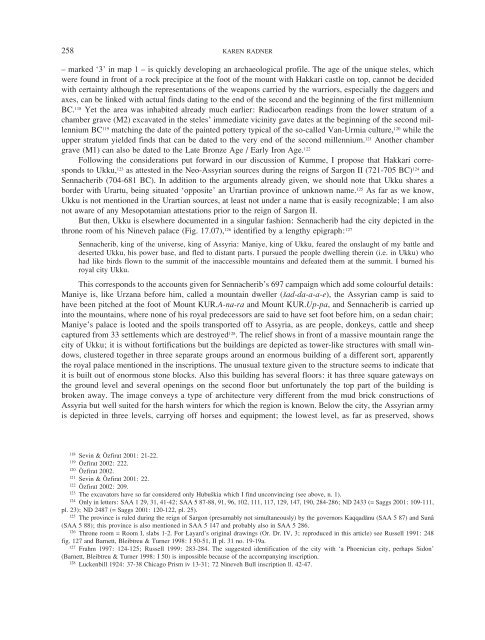Download PDF version of article - UCL
Download PDF version of article - UCL
Download PDF version of article - UCL
You also want an ePaper? Increase the reach of your titles
YUMPU automatically turns print PDFs into web optimized ePapers that Google loves.
258 KAREN RADNER<br />
– marked ‘3’ in map 1 – is quickly developing an archaeological pr<strong>of</strong>ile. The age <strong>of</strong> the unique steles, which<br />
were found in front <strong>of</strong> a rock precipice at the foot <strong>of</strong> the mount with Hakkari castle on top, cannot be decided<br />
with certainty although the representations <strong>of</strong> the weapons carried by the warriors, especially the daggers and<br />
axes, can be linked with actual finds dating to the end <strong>of</strong> the second and the beginning <strong>of</strong> the first millennium<br />
BC. 118 Yet the area was inhabited already much earlier: Radiocarbon readings from the lower stratum <strong>of</strong> a<br />
chamber grave (M2) excavated in the steles’ immediate vicinity gave dates at the beginning <strong>of</strong> the second millennium<br />
BC 119 matching the date <strong>of</strong> the painted pottery typical <strong>of</strong> the so-called Van-Urmia culture, 120 while the<br />
upper stratum yielded finds that can be dated to the very end <strong>of</strong> the second millennium. 121 Another chamber<br />
grave (M1) can also be dated to the Late Bronze Age / Early Iron Age. 122<br />
Following the considerations put forward in our discussion <strong>of</strong> Kumme, I propose that Hakkari corresponds<br />
to Ukku, 123 as attested in the Neo-Assyrian sources during the reigns <strong>of</strong> Sargon II (721-705 BC) 124 and<br />
Sennacherib (704-681 BC). In addition to the arguments already given, we should note that Ukku shares a<br />
border with Urartu, being situated ‘opposite’ an Urartian province <strong>of</strong> unknown name. 125 As far as we know,<br />
Ukku is not mentioned in the Urartian sources, at least not under a name that is easily recognizable; I am also<br />
not aware <strong>of</strong> any Mesopotamian attestations prior to the reign <strong>of</strong> Sargon II.<br />
But then, Ukku is elsewhere documented in a singular fashion: Sennacherib had the city depicted in the<br />
throne room <strong>of</strong> his Nineveh palace (Fig. 17.07), 126 identified by a lengthy epigraph: 127<br />
Sennacherib, king <strong>of</strong> the universe, king <strong>of</strong> Assyria: Maniye, king <strong>of</strong> Ukku, feared the onslaught <strong>of</strong> my battle and<br />
deserted Ukku, his power base, and fled to distant parts. I pursued the people dwelling therein (i.e. in Ukku) who<br />
had like birds flown to the summit <strong>of</strong> the inaccessible mountains and defeated them at the summit. I burned his<br />
royal city Ukku.<br />
This corresponds to the accounts given for Sennacherib’s 697 campaign which add some colourful details:<br />
Maniye is, like Urzana before him, called a mountain dweller (sad-da-a-a-e), the Assyrian camp is said to<br />
have been pitched at the foot <strong>of</strong> Mount KUR.A-na-ra and Mount KUR.Up-pa, and Sennacherib is carried up<br />
into the mountains, where none <strong>of</strong> his royal predecessors are said to have set foot before him, on a sedan chair;<br />
Maniye’s palace is looted and the spoils transported <strong>of</strong>f to Assyria, as are people, donkeys, cattle and sheep<br />
captured from 33 settlements which are destroyed 128 . The relief shows in front <strong>of</strong> a massive mountain range the<br />
city <strong>of</strong> Ukku; it is without fortifications but the buildings are depicted as tower-like structures with small windows,<br />
clustered together in three separate groups around an enormous building <strong>of</strong> a different sort, apparently<br />
the royal palace mentioned in the inscriptions. The unusual texture given to the structure seems to indicate that<br />
it is built out <strong>of</strong> enormous stone blocks. Also this building has several floors: it has three square gateways on<br />
the ground level and several openings on the second floor but unfortunately the top part <strong>of</strong> the building is<br />
broken away. The image conveys a type <strong>of</strong> architecture very different from the mud brick constructions <strong>of</strong><br />
Assyria but well suited for the harsh winters for which the region is known. Below the city, the Assyrian army<br />
is depicted in three levels, carrying <strong>of</strong>f horses and equipment; the lowest level, as far as preserved, shows<br />
118 Sevin & Özfirat 2001: 21-22.<br />
119 Özfirat 2002: 222.<br />
120 Özfirat 2002.<br />
121 Sevin & Özfirat 2001: 22.<br />
122 Özfirat 2002: 209.<br />
123 The excavators have so far considered only Hubuskia which I find unconvincing (see above, n. 1).<br />
124 Only in letters: SAA 1 29, 31, 41-42; SAA 5 87-88, 91, 96, 102, 111, 117, 129, 147, 190, 284-286; ND 2433 (= Saggs 2001: 109-111,<br />
pl. 23); ND 2487 (= Saggs 2001: 120-122, pl. 25).<br />
125 The province is ruled during the reign <strong>of</strong> Sargon (presumably not simultaneously) by the governors Kaqqadanu (SAA 5 87) and Sunâ<br />
(SAA 5 88); this province is also mentioned in SAA 5 147 and probably also in SAA 5 286.<br />
126 Throne room = Room I, slabs 1-2. For Layard’s original drawings (Or. Dr. IV, 3; reproduced in this <strong>article</strong>) see Russell 1991: 248<br />
fig. 127 and Barnett, Bleibtreu & Turner 1998: I 50-51, II pl. 31 no. 19-19a.<br />
127 Frahm 1997: 124-125; Russell 1999: 283-284. The suggested identification <strong>of</strong> the city with ‘a Phoenician city, perhaps Sidon’<br />
(Barnett, Bleibtreu & Turner 1998: I 50) is impossible because <strong>of</strong> the accompanying inscription.<br />
128 Luckenbill 1924: 37-38 Chicago Prism iv 13-31; 72 Nineveh Bull inscription ll. 42-47.

















